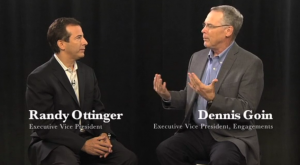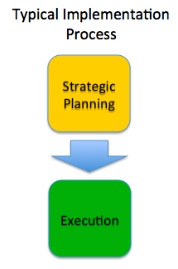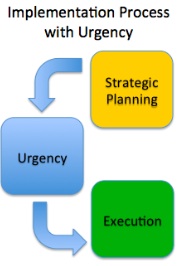
Leading Change Part 1: Replace Complacency with Urgency
It has become almost a cliché that the only constant today is change.
What moves it from a cliché to a truism is that the Greek philosopher Heraclitus said the same thing – 2,500 years ago.
In spite of that historical background, we all feel that change is different today: it is without end, and increasingly complex. We talk not of a single change, but of change as an ongoing phenomenon. It’s a collage, not a single simple image; one change overlaps with another, and it’s all change as far as the eye can see.
To some degree, the downside of change is inevitable. Whenever human communities are forced to adjust to shifting conditions, pain is ever present. But a significant amount of the waste and anguish we’ve witnessed in change management is avoidable.
The typical church has not operated well in a rapidly changing environment. Structure, systems, and culture have often been a drag on change rather than a facilitator.
The failure to sustain significant change recurs again and again despite substantial resources committed to the change effort, talented and committed people “driving the change,” and high stakes. In fact, leaders feeling an urgent need for change end up right: organizations that fail to sustain significant change end up facing crises.
This isn’t the sort of challenge you take on because it sounds good.
Adapting to and mastering change is not a choice. A significant part of a leader’s responsibility deals with being a change agent in the organization’s culture. In a time when changes come so fast and from so many unexpected angles, change is no longer a luxury but an imperative.
Even though change is a must for your organization, the “how-to’s” can often prove a problem. Many people lunge into change with no idea of its rules, its guiding principles, its nuances – and its dangers. Quite often disaster is the result. The only thing worse than ignoring change is leaping into it willy-nilly.
SOLUTION #1: Replace complacency with an urgency that motivates people
THE QUICK SUMMARY – A Sense of Urgency, by John Kotter
Most organizational change initiatives fail spectacularly (at worst) or deliver lukewarm results (at best). In his international bestseller Leading Change, John Kotter revealed why change is so hard, and provided an actionable, eight-step process for implementing successful transformations. The book became the change bible for managers worldwide.
Now, in A Sense of Urgency, Kotter shines the spotlight on the crucial first step in his framework: creating a sense of urgency by getting people to actually see and feel the need for change.
Why focus on urgency? Without it, any change effort is doomed. Kotter reveals the insidious nature of complacency in all its forms and guises.
In this exciting book, Kotter explains:
· How to go beyond “the business case” for change to overcome the fear and anger that can suppress urgency
· Ways to ensure that your actions and behaviors — not just your words — communicate the need for change
· How to keep fanning the flames of urgency even after your transformation effort has scored some early successes
Written in Kotter’s signature no-nonsense style, this concise and authoritative guide helps you set the stage for leading a successful transformation in your company.
A SIMPLE SOLUTION
You know your organization needs to change.
You may even know what the change needs to be: a new strategy, new personnel, new technology, or a significant change in direction.
But somehow, change comes too slowly, or it feels like you are pushing a boulder uphill, or that the implementation of that great new idea has stalled – again.
What’s missing, and is needed in almost all organizations today, is a real sense of urgency – a distinctive attitude and gut-level feeling that leads people to grab opportunities and avoid hazards, to make something important happen today, and constantly shed low-priority activities to move faster and smarter, now.
The real solution to the complacency problem is a true sense of urgency. Real urgency is an essential asset that must be created and re-created.
This set of thoughts, feelings, and actions is never associated with an endless list of exhausting activities. It has nothing to do with anxious running from meeting to meeting. It’s not supported by an adrenalin rush that cannot be sustained over time.
True urgency focuses on critical issues, not agendas overstuffed with the important and the trivial. True urgency is driven by a deep determination to win, not anxiety about losing. With an attitude of true urgency, you try to accomplish something important each day, never leaving yourself with a heart-attack-producing task of running one thousand miles in the last week of the race.
Increasing a True Sense of Urgency
Strategy
Create action that is exceptionally alert, externally oriented, relentlessly aimed at winning, making some progress each and every day, and constantly purging low value-added activities – all by always focusing on the heart and not just the mind.
Tactics
- Bring the Outside In
- Reconnect internal reality with external opportunities and hazards
- Bring in emotionally compelling data, people, video, sites, and sounds
- Behave with Urgency Every Day
- Never act content, anxious, or angry
- Demonstrate your own sense of urgency always in meetings, one-on-one interactions, memos, and email and do so as visibly as possible to as many people as possible.
- Find Opportunity in Crises
- Always be alert to see if crises can be a friend, not just a dreadful enemy, in order to destroy complacency.
- Proceed with caution, and never be naïve, since crises can be deadly.
- Deal with the NoNos
- Remove or neutralize all the relentless urgency-killers, people who are not skeptics but are determined to keep a group complacent or, if needed, to create destructive urgency.
John Kotter, A Sense of Urgency
A NEXT STEP
Author Jon Kotter has developed a set of useful questions to consider when facing complacency and false urgency.
Discuss the following questions with your team, and identify – and eliminate – sources of complacency and false urgency.
- Are critical issues delegated to consultants or task forces with little involvement of key people?
- Do people have trouble scheduling meetings on important initiatives?
- Is candor lacking in confronting the bureaucracy and politics that are slowing down important initiatives?
- Do meetings on key issues end with no decisions about what must happen immediately (except the scheduling of another meeting)?
- Do people run from meeting to meeting, exhausting themselves and rarely if ever focusing on the most critical hazards or opportunities?
- Do people regularly blame others for any significant problems instead of taking responsibility and changing?
- Are failures in the past discussed not to learn but to stop or stall new initiatives?
Excerpt taken from SUMS Remix 102-1, issued September 2018.
This is part of a weekly series posting excerpts from one of the most innovative content sources in the church world: SUMS Remix book excerpts for church leaders.
Each issue SUMS Remix takes a practical problem in the church and looks at it with three solutions; each solution is taken from a different book. Additionally, a practical action step is included with each solution.
As a church leader you get to scan relevant books based on practical tools and solutions to real ministry problems, not just by the cover of the book. Each post will have the edition number which shows the year and what number it is in the overall sequence. (SUMS Remix provides 26 issues per year, delivered every other week to your inbox).
>> Subscribe to SUMS Remix <<

Tags: A Sense of Urgency, Change, Complacency, False Urgency, John Kotter




























